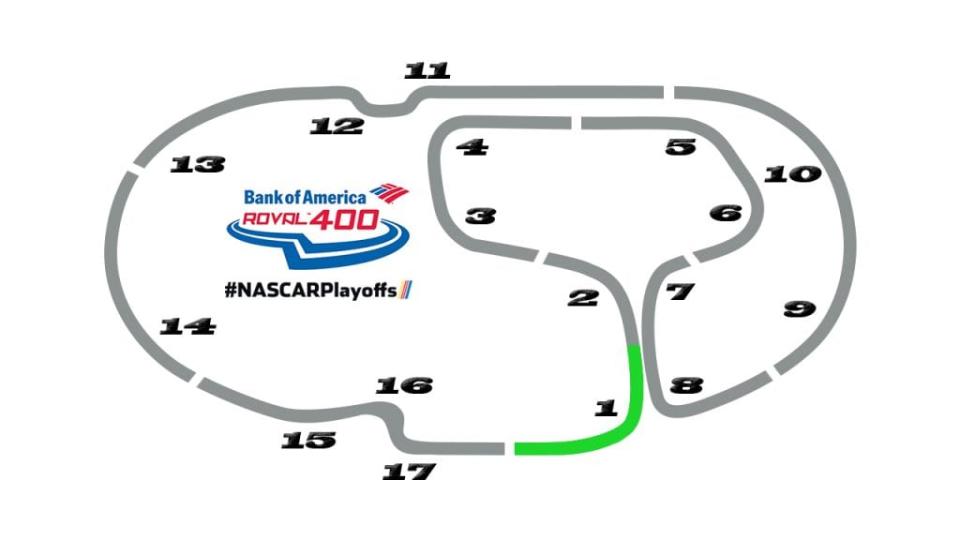NASCAR's latest playoff experiment happens Sunday at Charlotte's Roval
Since its inception in 2004, NASCAR’s playoff format has been one giant experiment. The playoffs have changed every three years or so as NASCAR has tried to find what it thinks is the ideal playoff format.
Within the playoff schedule, however, there hasn’t been much experimenting. The Cup Series’ 10 playoff races have been pretty consistent over the first 14 years, much to the chagrin of fans who have found that NASCAR’s most fun races have come on road courses, a type of track that had no representation at the end of the season.
Sunday’s race at the Charlotte Motor Speedway road course-oval hybrid is the first race with right turns in NASCAR playoff history. And it’s one hell of an experiment. Not only is it the first time the Cup Series has run a road course-type race in the playoffs, it’s the first Cup Series race and just second NASCAR series race overall at what Charlotte calls the “Roval.”
No one has any idea what will happen. That’s good for marketing; NASCAR and Charlotte have been pushing the race ever since it was announced. The potential for unpredictability and drama is high, especially as the 16-driver playoff field is pared to 12 following Sunday’s race. Only four drivers will be guaranteed berths into the second round of the playoffs when the green flag drops, leaving 12 drivers scrambling for eight spots.
That potential serves the hype machine well. The Roval may have the most pre-race intrigue of any race since the 2014 season finale at Homestead, the first winner-take-all title race. But NASCAR had been racing on Homestead’s current configuration since 2003. The fall race at Charlotte has always been on the standard 1.5-mile oval.
As NASCAR moved in 2017 to add a bit of predictability to the playoffs with yet another overhaul of the points system, the addition of a new course layout is a wrench of randomness.
“I’m not sure that guys are really completely sold yet that the Roval’s going to stick to the schedule for years to come,” Kyle Busch told Yahoo Sports on Monday. “It might be such a — not a good show that they just might have to go back to the oval.”
If there’s a hypothesis for the race, it involves a lot of wrecks in some form or fashion. That works well for the pre-race intrigue. It’s easy to sell a race that has the potential for crumpled sheet metal and drivers moving each other out of the way, especially the week after a Richmond race that featured just one non-stage break caution.
It’s reasonable to think a successful race would be one that has a lot of lead changes, passing throughout the field because of driver mistakes and aggression and a few crashes thrown in along the way. But not too many.
“If we run half the race under yellow and caution flag periods then that’s not going to be very much fun for the race fan,” Busch said.

The expectation for crashing and unpredictability comes from the track’s layout and the lack of grip drivers expect to have in certain sections. The Roval includes all four of the oval’s turns, two chicanes, and a slow infield section between the start-finish line and where drivers re-enter the oval portion of the track in what typically is turn 1. That infield section will probably be the most treacherous part of the track.
“The thing about the track is it’s cobbled together and there’s no passing zones,” Chase Elliott said Tuesday. “The race track doesn’t flow like a typical road course does and should, but that being said there’s a lot of corners that are just awkward and weird angles getting into the corners and when that happens you’ll have — when you don’t have a straight line braking zone it’s basically up to the guy behind you as to whether or not he wants to just dive in there and cut the corner and get to you. So the option’s always going to be there for the person to get to you and crash you with the way the angles of the corners are.”
Busch also said that the tire Goodyear chose for the race weekend doesn’t provide much grip in the slower infield portion of the course.
“The tire and the track just don’t necessarily match up very well,” Busch said. “We’ve done a couple tire tests and they decided to go against the driver’s wishes on what tire they chose. Overall it’s just a slow section of the race track in the infield portion that you’re not making a lot of miles an hour so you’re not making a lot of downforce so you’re relying solely on that tire and it’s just going to make for some tense moments.”
Teams are also going to have less than an hour of practice time on Friday to get acclimated to the course before qualifying. Starting up front would seem to be even more important than normal in a race like this. But figuring out how to balance the importance of qualifying at layout where everyone would like to have as many laps as possible is tenuous.
“We only have three sets of tires really to practice on,” Joey Logano said. “So how are you going to manage your practice? Will you unload in qualifying trim and stay in qualifying trim for 50 minutes and you make three laps total before you go qualify? Does that get you in enough of a groove and learn the racetrack quick enough to be successful when it comes to qualifying?”
Logano and Elliott would benefit greatly by starting up front. Neither are among those four drivers (Busch, Kevin Harvick, Brad Keselowski and Martin Truex Jr.) who know they’re heading to the second round. But both are currently in the top 12. Getting points in the first stage could be pivotal if the race devolves into a wreckfest.
Or maybe, as Elliott wonders, some reverse psychology will come into play when the green flag flies.
“The talk has just been constantly about how much we’re going to crash and I don’t disagree with that in a sense,” Elliott said. “I just kind of wonder if all the talk about it, maybe people will be a little smarter since we’ve all talked about it and not crash the field early in the race and at least have a chance to go race.”
– – – – – – –
Nick Bromberg is a writer for Yahoo Sports.


